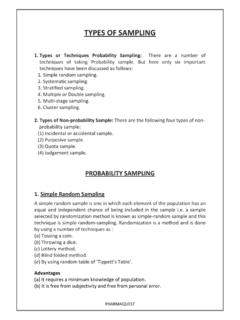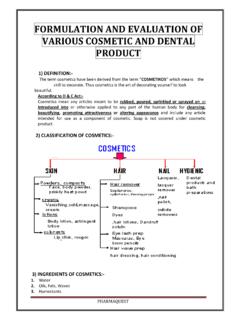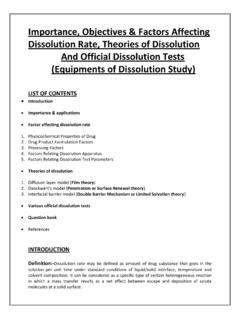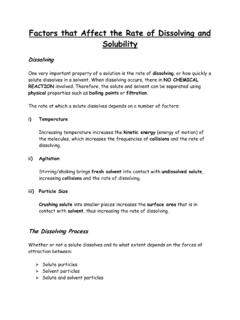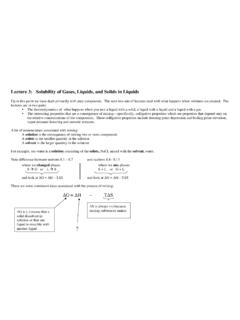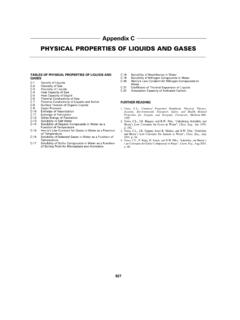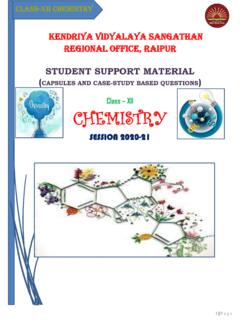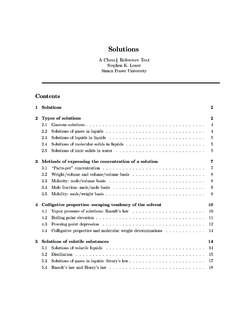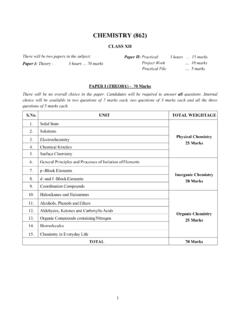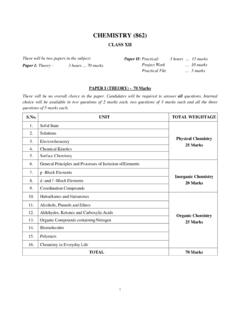Transcription of INTRODUCTION & APPLICATION OF SOLUBILITY & …
1 INTRODUCTION & APPLICATION OF SOLUBILITY & SOLUBILIZED SYSTEM CONTENT: - 1. Aim Of Studying SOLUBILITY 2. Definition Of SOLUBILITY 3. Types Of SOLUBILITY 4. Mechanism Of Solubilization 5. Factors Affecting SOLUBILITY 6. APPLICATION of SOLUBILITY 7. Reasons For Insolubilization Of Drugs 8. Questions AIM OF STUDING SOLUBILITY : - Currently only 8% of new drug candidates have both high SOLUBILITY and permeability Some knowledge is important to pharmacist, for it permitting him to chose, 1. The best solvent medium for a drug or combination of drugs. 2. Help in overcoming certain difficulties that arises in the preparation of pharmaceutical solution. 3. And further more, can serve as a standard test of purity. DEFINITIONS: - 1. SOLUBILITY is defined as the number of milliliters of solvent in which 1 gm of solute will dissolve. 2. Saturated solution is one in which the solvent is in equilibrium with the solid phase (solute).
2 3. Unsaturated solution is one containing the dissolved solute in a concentration below that necessary for complete saturation at a definite temperature. 4. A supersaturated solution is one that contains more of the dissolved solute than it would normally contain at a definite temperature. sodium thiosulfate can be dissolved in large amounts at an elevated temperature and, upon cooling fails to crystallize from the solution. Descriptive term Approximate volume of solvent in milliliters per gram of solute very soluble less than 1 freely soluble from 1 to 10 Soluble from 10 to 30 sparingly soluble from 30 to 100 slightly soluble from 100 to 1000 very slightly soluble from 1000 to 10,000 insoluble or practically insoluble more than 10,000 Types Of SOLUBILITY 1. SOLUBILITY of gases in liquids 2. SOLUBILITY of liquids in liquids 3. SOLUBILITY of solids in liquids of gases in liquids Pharmaceutical solution of gases includes hydrochloric acid, ammonia water, and effervescent preparation containing carbon dioxide (Aerosol) that are dissolved and maintained in solution under positive pressure.
3 The SOLUBILITY of such system depends primarily on the pressure, temperature, presence of salts, and chemical reaction (salting out). Effect of pressure = as the pressure increases the SOLUBILITY of gases are also increased. So the effect of pressure is important while considering the SOLUBILITY of dissolved gases in Aerosolized products. Effect of temperature = as the temperature increases the SOLUBILITY of most of the gases decreases. of liquids in liquids Frequently two or more liquids are mixed together in the preparation of pharmaceutical solutions. Alcohol is added to water to form hydroalcoholic solution. Volatile oils are mixed with water to form aromatic water. Volatile oils are mixed with alcohol to yield elixirs and spirits. of solids in liquids Steps of solid going into solution. Step 1: Hole open in the solvent, Step 2: One molecule of the solid breaks away from the bulk, Step 3: The solid molecule is enter into the hole in the solvent MECHANISM OF SOLUBILIZATION: - Polar solvents 1.
4 Owing to their high dielectric constant, polar solvents reduces the force of attraction between oppositely charged ions in crystals 2. Polar solvents break covalent bonds of potentially strong electrolytes by acid base reactions 3. Polar solvents are capable of solvating molecules and ions through dipole interaction forces, particularly hydrogen-bond formation, which leads to the SOLUBILITY of compound. However the nonpolar solvents won t obey the above mechanism of solubilization, so they are unable to dissolve the ionic and polar solutes. Nonpolar solvents can dissolve the nonpolar solute with similar internal pressure through induced dipole interactions. In short solubilization takes place by consideration of, 1. Polarity 2. Dielectric constant, 3. Association, 4. Salvation, 5. Internal pressure, 6. Acid-base reaction. FACTORS AFFECTING SOLUBILITY SOLUBILITY of a compound depends upon the physical and chemical properties of the solute and the solvent, as well as upon factor such as, 1.
5 TEMPERATURE 2. pH 3. PARTICLE SIZE 4. CRYSTAL STRUCTURE 5. MOLECULAR STRUCTURE 6. NATURE OF SOLVENT 1. TEMPERATURE Generally as the T increases the SOLUBILITY increases. For effect of T on SOLUBILITY we have to take consider two criterias Basically, SOLUBILITY increases with temperature. It is the case for most of the solvents. The situation is though different for gases. With increase of the temperature they became less soluble in each other and in water, but more soluble in organic solvents. 1. ENDOTHERMIC REACTIONS During dissolution process the energy (heat) is absorbed. Thus rise in T will lead to an increase SOLUBILITY of a solid in the solution with a positive heat of solution. 2. EXOTHERMIC REACTIONS During dissolution process the energy (heat) is evolved. Thus rise in T will lead to a decrease SOLUBILITY of a solid in the solution with a negative heat of solution.
6 NON-POLAR COMPOUNDS The forces holding the particles together are small, and any interaction between solute and solvent is small. Not detectable heat effect on NON POLAR substance. POLAR COMPOUNDS Either decrease OR increase in SOLUBILITY . In polar substances, it takes energy to separate the molecule from surrounding molecules & if energy is supplied in the form of heat, producing a cooling effect. Also there is the possibility of interaction between the solute and solvent with formation of a dipole-dipole type bond, and this interaction will tend to give off heat. Depending on which of the two interactions is greatest you can get an increase or decrease in temperature. 2. pH We have to consider for 1. NONIONIZABLE SUBSTANCES Little effect of pH on nonionizable substances. SOLUBILITY can be increased by change of dipole moment.
7 2. IONIZABLE SUBSTANCES Depends on HEDERSON-HESSELBALCH equation. For Acidic drug pH= pKa+log [(S-S0)/S0] S=Over all SOLUBILITY of substance For basic drug So= SOLUBILITY of unionized species pH= pKa+log [S0/(S-S0)] S-So= SOLUBILITY of ionized species pH of a substance is related to its pKa and the concentration of the ionized and unionized forms of the substance. The effect of pH on a weak acid (A) and a weak base (B) 3. PARTICLE SIZE As the decreases SOLUBILITY increases due to increase in the surface area. But after very small decrease in will decreases SOLUBILITY due to formation of agglomerates. log S/S0=[2 r] S= SOLUBILITY of small particle of radius r M=molecular weight S0=normal SOLUBILITY R=gas constant =surface tension =density 4.
8 CRYSTAL STRUCTURE Amorphous form of drugs is more soluble than Crystalline form. SOLUBILITY : SOLVATES >ANHYDROUS > HYDRATES Effect of crystal structure on SOLUBILITY is explained in chapter of preformulation in subtopic crystallinity. 5. MOLECULAR STRUCTURE Change in the molecular structure highly affects SOLUBILITY of compound. eg. INTRODUCTION of the hydrophilic group in hydrophobic substance may improve SOLUBILITY . Examples 1. INTRODUCTION of hydrophilic group Benzene into phenol with increased SOLUBILITY . 2. Conversion into salt Generally all salt forms are soluble. 3. Esterification Chloramphenicol into palmitate form for taste masking. 6. PRESSURE solid and liquid solutes For majority of solid and liquid solutes, pressure does not affect SOLUBILITY . Gas Solute As for gases the Henry's law states that SOLUBILITY of gas is directly proportional to the pressure of this gas.
9 This is mathematically presented as: p = kc, where k is a tempreture dependent constant for a gas. A good proof of Henry's law can be observed when opening a bottle of carbonated drink. When we decrease the pressure in a bottle, the gas that was dissolved in the drink bubbles out of it. APPLICATION OF SOLUBILITY SOLUBILITY is of fundamental importance in a large number of scientific disciplines and practical applications, to the use of medicines, and the transport of pollutants. SOLUBILITY is represents a fundamental concept in fields of research such as chemistry, physics, food science, pharmaceutical, and biological sciences. The SOLUBILITY of a substance becomes specially important in the pharmaceutical field because it often represents a major factor that controls the bioavailability of a drug substance.
10 SOLUBILITY is commonly used to describe the substance, to indicate a substance's polarity, to help to distinguish it from other substances, and as a guide to applications of the substance. SOLUBILITY of a substance is useful when separating mixtures. Moreover, SOLUBILITY and SOLUBILITY -related properties can also provide important information regarding the structure of drug substances, and in their range of possible intermolecular interactions. For these reasons, a comprehensive knowledge of SOLUBILITY is essential. WHY DRUGS ARE INSOLUBLE: - SOLUBILITY of drug is largely due to, 1. Polarity of the solvents, that is, to its dipole moment. A polar solvent dissolves ionic solutes and other polar substances 2. The ability of solute to form hydrogen bond with solvent. 3. Also depends on the ratio of the polar to nonpolar groups of the molecule.

